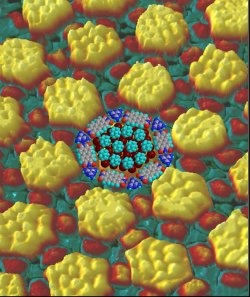Aug 28 2008
A crucial step in developing minuscule structures with application potential in sophisticated sensors, catalysis, and nanoelectronics has been developed by Scottish researchers.

Dr Manfred Buck and his team at the University of St Andrews have accomplished one of the big quests in nanotechnology, opening up an exciting new development in tiny technology.
The St Andrews researchers have developed a way of forming an easily modified network of molecules over a large area - the chemical technique provides an advantageous alternative to traditional methods which become increasingly cumbersome at the ultrasmall length scale.
The key to the development lies in the creation of robust and versatile surface - self-assembling structures just one molecule thick which can be exploited for further control and manipulation of nanostructures.
Dr Manfred Buck, of the University¿s School of Chemistry, explained, "One of the central issues in nanotechnology is the development of simple and reliable methods to precisely arrange molecules and other nanoscopic objects. One promising route intensively investigated by scientists around the world involves the ability of molecules to spontaneously assemble onto a surface. What we have done is successfully combined two strategies which are complementary but, so far, have been explored independently, and it is this combination which opens up unprecedented opportunities for accessing the ultrasmall length scale."
"The potential of this approach lies in its flexibility on a scale, about 1/10000 of the diameter of a human hair. Using molecules as building units, the features of our structures are less than 5 nanometres in size, which enables us to control structures and materials at dimensions where new properties emerge."
One of the advantages of the technique is that it works under ambient conditions. Since no sophisticated equipment or special environment - such as a high vacuum - is required, it is easily accessible and adaptable for a wide range of applications. The chemical method provides an alternative route to nanostructures created by conventional lithography, which inscribes patterns into surfaces but struggles to be precise on a scale of a few nanometres.
Dr Buck's solution-based chemistry works by assembling molecules into tiny dimples, themselves created when molecules self-assemble into a honeycomb-shaped network on a gold surface. Such a so-called supramolecular network is held together by hydrogen bonds -a type of bonding also essential for DNA - and acts as a template to control the arrangement of other molecules.
He continued, "We are just at the beginning of the exploration of a very exciting new area. Ongoing and future work will investigate changes in the dimensions and geometry of the network, where the aim is to get exact control over the arrangement of molecules, ultimately at the level of single molecules."
"In the short term, this development provides us with an easily accessible platform for fundamental studies of phenomena on the ultrasmall scale," Dr Buck explained.
"In the future, we might be able to use this technology for the assembly of 'nanomachines', molecular devices used to transport and manipulate molecules and nanometer sized objects," he concluded.
The research is published by the journal Nature.